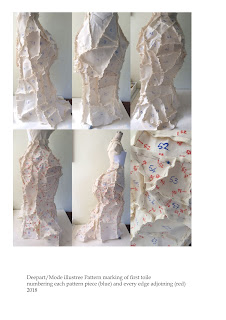What is happening already in digital fashion? (week 24)
 |
| Deep Art Algorithm and Hewitt, J. (2018) Tokyo Drift |
What is your own understanding and interpretation of the Transitions conference ideas?
In order to start getting my ideas together to talk about in our next group session, I've been looking at the digital manufacturing areas already being researched and exploited.
The Transitions Conference is bringing together a wide variety of experts and companies across disciplines to share knowledge, learn and develop new ways of working, new materials and new technologies. The statistics of waste and pollution created by the textile industries is very sobering. It is vital that the industry moves forward at the same swift pace that other industries have to rectify damage done to the planet already and create a new sustainable future. This can be achieved in a variety of ways and the conference themes explore many of them.
Suuchi Ramesh flags up 5 areas of development
Supply chain integration
One-off print customisation
Made to order fit customisation
Virtual design, toiling and patterning
Robotic workplace assistance and machining
Companies such as flex PLM have very sophisticated integration concepts already being used. The internet of things is likely to develop this further as stock sales can be seen immediately, relayed to the manufacturer, designs changed, fabric ordered etc on-the-fly with ever shorter time delays between departments. Downside to this is obviously cost, it is a solution for large businesses rather than small ones it requires a sophisticated software network with training for all employees... print customisation could enable short runs to be created ad hoc, again we are seeing this already with companies such as Spoon flower creating print on demand fabrics for the home sewing market available from customers own artwork or purchasable designs from artists in the system.
Made to order fit customisation can be done to a certain extent with digital patterning software, optitex, marvellous designer etc but we are a way off having a pattern created that is guaranteed to fit perfectly from a persons bodyscan... this would involve tying together several techniques, the initial bodyscan, a digital blocks creation, a digital 3D mannequin and then digital patterning software creating the cutting and sewing template... could this be a great boon for the home sewing market?
The initial outlay on equipment to fully digitise a process for one-off garments seems unlikely at this point, but if you could have one design that could be viewed on a mannequin of your body in VR ordered online, altered to a custom fit, manufactured and delivered in one smooth process, you are reaching towards the ideal chain of production, vastly reducing waste as every garment has been seen from every angle, approved, perfect fit guaranteed... Ok this is an interesting idea... it may already have been thought of but definitely one to investigate further.
Virtual design, toiling and pattern creation is obviously an area of interest to me. I keep being assured that there is software already that does these things, (optitex marvellous designer etc) but it certainly doesn't seem to be accessible, easy to use or being taught as standard... perhaps better access to these technologies at an early and basic level is an area for change/development in the fashion industries? I shall download the marvellous designer 30 day trial and have a play....
Robotic workplace - machines are already utilised, lazer cutters etc 3D print is gathering traction but fabric is still a bit of a cul de sack... knitted objects in extruded plastic and big solid resin dresses whilst spectacular are not very pret a porter... we are a long way off having a printer in every home that can genuinely cater to our every need... but it's not beyond the realms of possibility...
Recycling of 3D printed material could be an interesting area? Is it possible to disintegrate the fibres and reuse? Could old clothes be broken down and reassembled in sticks of fibre form, held together with cellulose dis-integratable glue to be knitted and then washed leaving only fully constructed fibres? Possibly also worth investigating further...
Also of course in this area we have the whole robots/AI/human relationship and ethics section... how are we all going to interact together, what rules need to be put in place? (Asimov)



Comments
Post a Comment